Front Lever
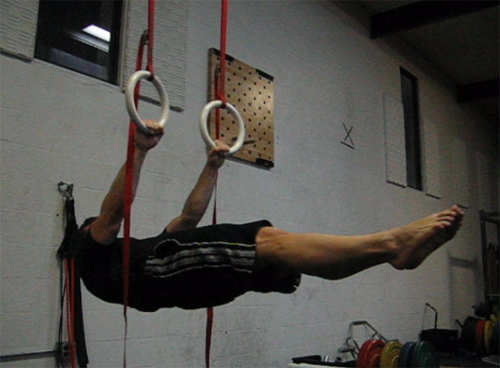
The front lever is a skill which looks easily attainable, but some may find themselves struggling with the just the basic progressive exercises. After the back lever, the front lever is a skill that one should strive to attain in order to strengthen up the midsection and upper body. You can perform it on the rings or bar, making it a skill that anyone can work on.
Let’s first look at the lever and the specifics of the skill.
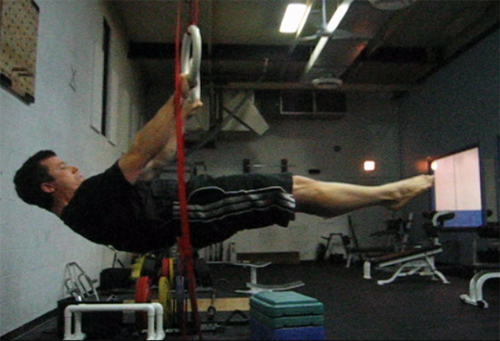
Hands
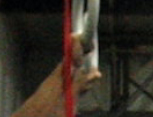
The palms of the hands should be facing downwards. In fact, you should be actively trying to push in this direction during the skill. This will engage the proper muscles in the upper body. In also helps to squeeze the rings or bar with your hands in order to generate more tension in the upper body and subsequently create a stronger lever. Also take note in the top picture that my hands are in a vertical line with my hips. This will occur naturally as the body strives to balance in the position.
Arms
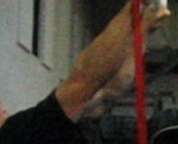
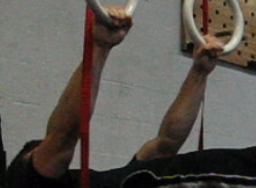
Keep them close by the side, shoulder width apart. On the bar, this is easily accomplished by the width at which you set your hands. On the rings, you must be aware of keeping the arms in close by the side. In both cases, you do not want to think of squeezing the arms inwards, so much as flexing the entire upper body and keeping the arms glued to the side of the body. This is very similar to the back lever. If they float away from your torso, you’ll have a much harder time keeping tension.
Shoulders + Upper Torso
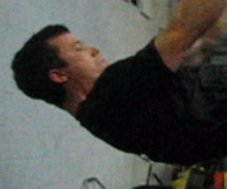
Flex the back (latissimus dorsi) and the chest, and the shoulders should stay in a relatively natural position. There’s no need to retract the shoulder blades or push the shoulders forward unnaturally. As was previously described, you’ll want to actively push downwards with your hands, which will generate the correct tension in the upper body.
Midsection/Hips/Legs
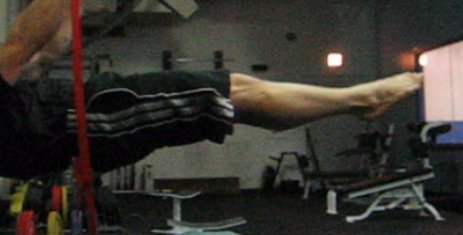
Keep the midsection tight, squeeze the butt and the legs too. Make sure that the front of the body is in line. Where you will often encounter difficulty with the skill is keeping the hips extended. Do not bend at the middle, as it’s not proper form for the front lever (seen below).
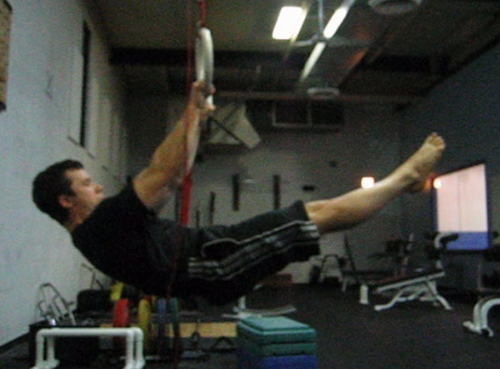
bending at the hips = incorrect form
I find that pointing your toes and thinking of stretching out your body to be a good cues to keep yourself inline, much as it is for the handstand. When in doubt, take a picture or have someone spot your form.
.jpg)
And as you can see from my head and eyes, I’ll watch my feet as well to make sure that I’m not only in a straight line with my body, but that I’m horizontal to the ground.
Complimentary Exercises
Pullover/Straight Arm Pulldown
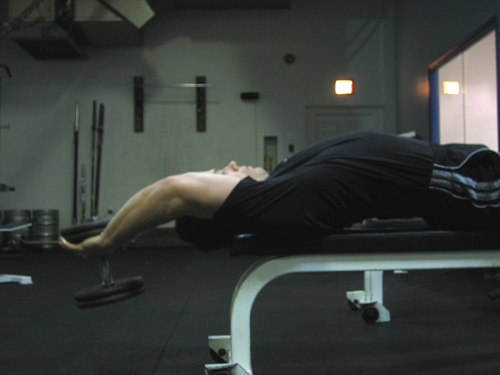
dumbbell pullover
If you are completely new to this skill, then it may help to work the pullover and/or the straight arm pulldown in order to strengthen up the necessary muscles. I’m aware that the pullover is not quite the same stress on the muscles as the front lever, but it’s easy to do in most training facilities, is similar enough for our purposes, and will get you strong enough to start working the other progressive exercises. Once you are able to work on the basic lever positions, this exercise is limited in its usefulness.
Weighted Pullups
I’ve found that weighted pullups (palms facing away from the body) to have a fairly good carryover to the front lever. The hands are applying force in a similar direction.
Work the pullups with both a shoulder-width grip, and a slightly wider grip as well. Whichever distance your hands are, try to lean back slightly and touch your chest to the bar with each repetition. This complete range of motion will help to build up the necessary strength.
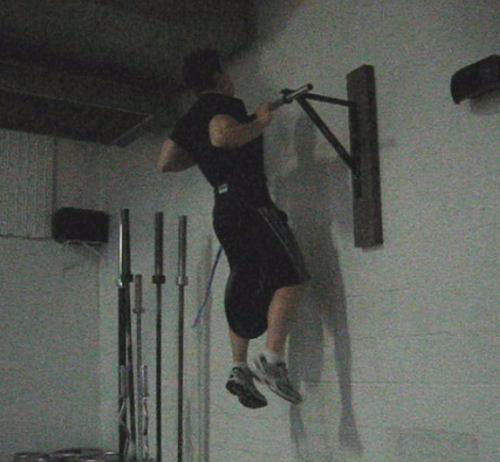
weighted pullup with 45 lbs
You can also try to do the pullups with your arms a bit straighter than they need to be. This will put your body behind the bar slightly and you won’t be leaning back as much as you would during a normal pullup.
The difference between a regular pullup and this straighter arm technique was touched upon in the muscle-up tutorial.
.jpg)
.jpg)
regular pullup (left) versus a straighter arm pullup (right)
If you pull with straighter arms, don’t worry about touching the bar or getting your chin above it, just get up as high as you can. Try to work these mainly in the lower rep range (around 5) in order to build the necessary strength.
Inverted Rows
If pullups through a full range of motion are too difficult, put your feet on the ground and find something to row towards – whether it’s a bar set in the rack, or some rings set close to the ground.
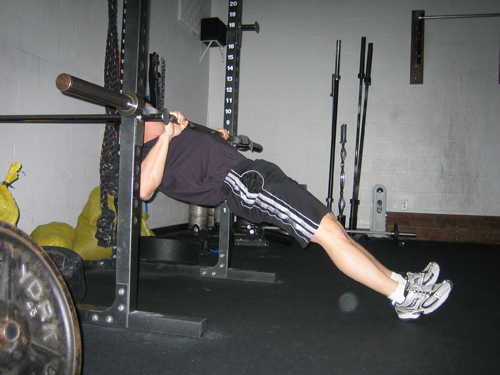
Progressive Positions
Tuck Lever
The very first position that we want to acquaint ourselves with is the tuck lever. This is simply the front lever with your legs tucked in. Notice that my hips and shoulders are the same height off the ground.
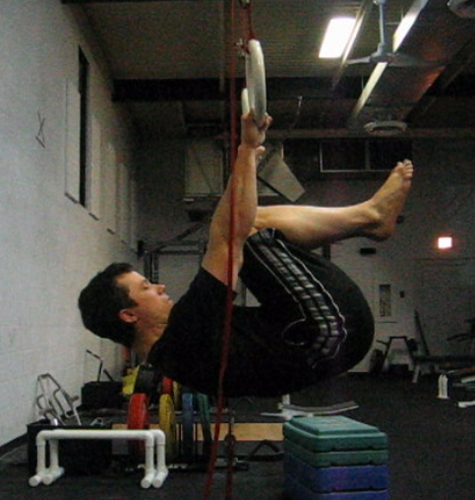
the tuck lever
Negatives
You may have trouble just holding this position at first, so I recommend getting yourself upside-down anyway you can and lowering yourself down and through the position. The picture below would be the position I would begin with before lowering down slowly into the tuck lever position.
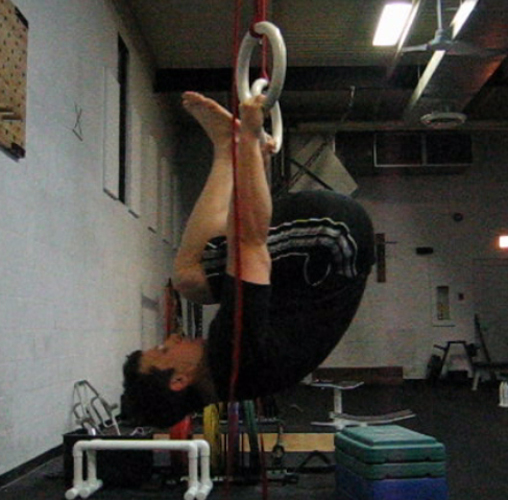
getting ready to lower into the tuck lever
Rings have a slight advantage at this point, as you’ll be able to move them close to the ground and use your legs to kick yourself upside-down. Even if you find yourself with a bar, find some way to get yourself upside-down. And please, don’t let go at this point.
As you lower down, try to think of flexing the upper body and pushing the hands downwards to slow your descent. Also think of bringing your shoulders behind your hands, so that the body can properly balance. If your shoulders are directly underneath your hands, then there’s no way your hips and torso are going to stay up. Notice in the picture below, as lines are drawn straight down from the hands and the shoulders, that the shoulders are clearly behind the hands.
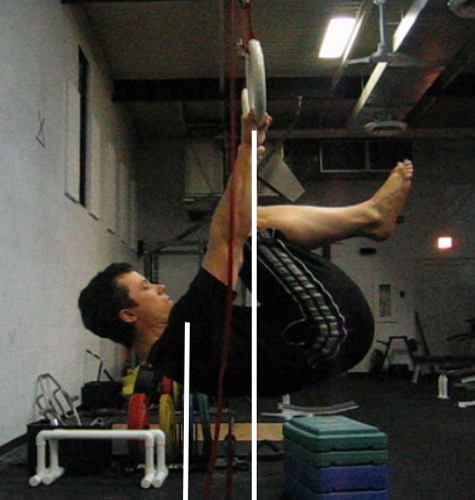
shoulders behind hands
Tuck Lever – Hold
After working the negative motion through the tuck lever, you’ll eventually find that you can slow down the skill and stop it at certain points. When you can stop the skill with your hips and shoulders in a horizontal line, then begin working the hold for extended periods. As I mentioned before, I like to look down at my feet to determine when my body has hit the correct position.
Good ways to measure progression at this point is to count to yourself and try to beat your previous times. Or to try and reach a predetermined period of time (e.g., 60 seconds) in the least amount of holds.
Tuck Lever – Pull Up To and Through
When you find yourself able to hold the tuck lever position for an extended period of time (over ten seconds, at least). Then you can try pulling up into the position. This is much harder than lowering down into the tuck lever.
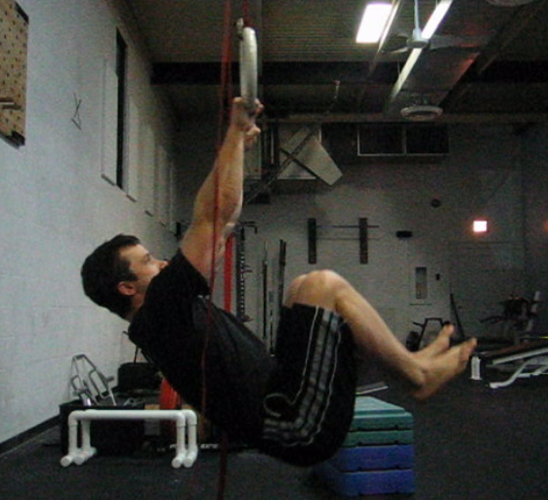
Make absolutely sure that you bring your shoulders back as you pull downwards. Look at the picture above and see how my shoulders are already behind the hands. Failure to do so will make it physically impossible to come up into the skill.
You can pull yourself up into the tuck lever position, or through the position and upside-down then back down to a hanging position (skin the cat). Doing this for reps gets very tiring and is a great exercise.
Skin the Cat
At this point, you can also start working the skill – “skin the cat”. Many have probably already done this on the playground when they were younger. It involves pulling yourself up and through the lever position, so that the body drops to the other side and the arms are twisted around, yet the palms remain in the same forward position. You can then pull yourself back through to the original hanging position.
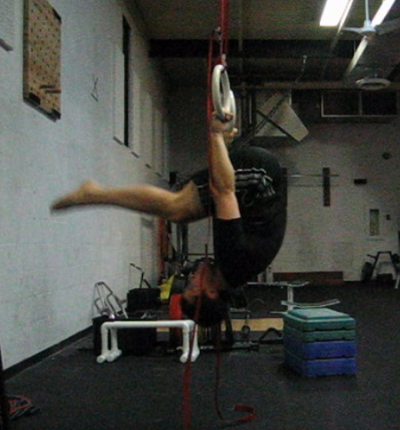
upside-down
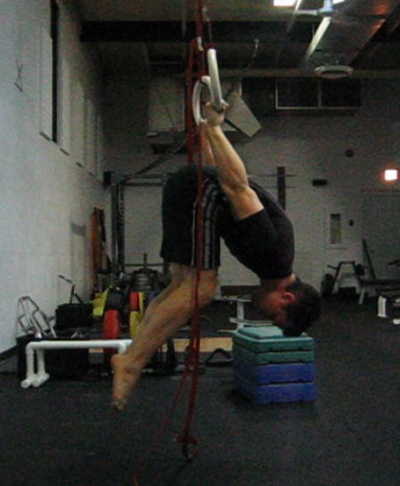
back through
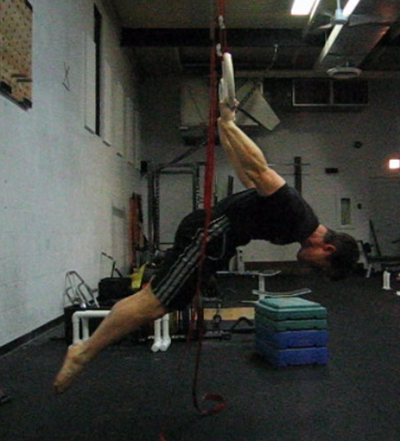
and extend the hips
Rings again have an advantage, as it’s easier to clear your feet than it is on a bar.
Tuck Lever Pullups
Another exercise to work on is the tuck lever pullup. This is a difficult exercise, so just try to get as high as you can. The one obvious characteristic of this pullup is to keep your hips and shoulders in one horizontal line. You can face your palms towards each other, or down towards your feet.
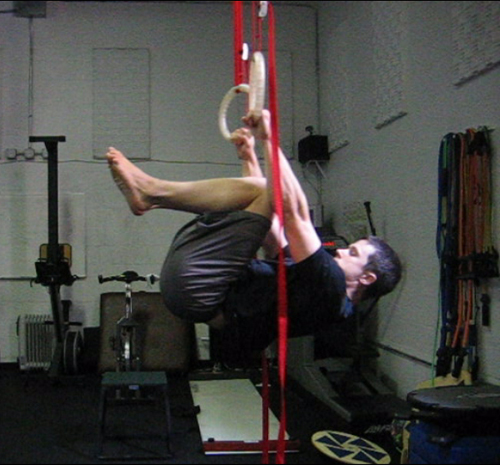
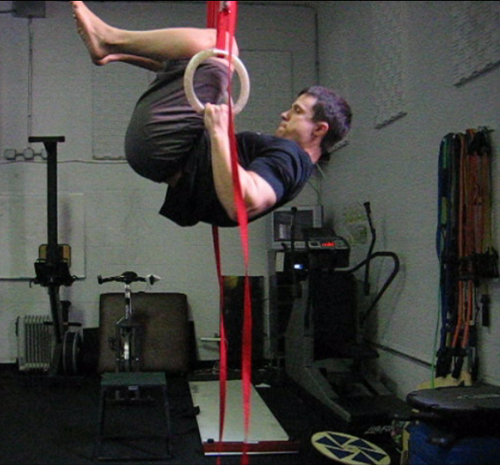
Beyond
Any progressive exercises beyond this will use the same techniques and exercises as the tuck lever:
1) Lowering down through the skill
2) Holding the skill
3) Pulling up to and through the skill
4) Pullups in the position
The only difference is the position that the body is held. The more you stretch out and open the body, the harder the exercise will be. Some positions to then try (in order of increasing difficulty) are:
Advanced tuck
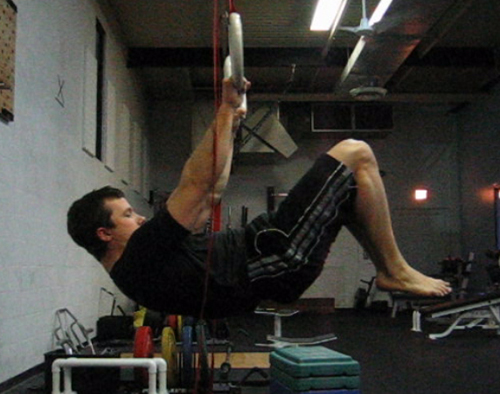
Open up the body more, but still keep the knees bent. I found it helps to press your legs together, so that your legs move as one single unit. Again, notice that my shoulders and hips are at the same level above the ground.
Single leg front lever
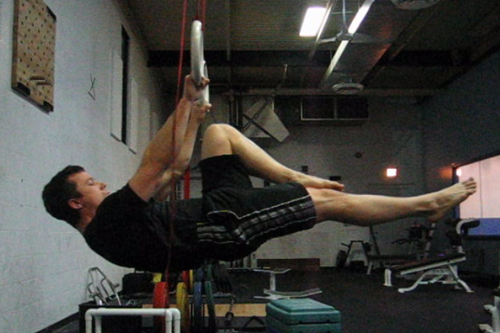
One leg in, one leg out. A great exercise is to hold this position while switching your legs back and forth.
Straddle Front Lever
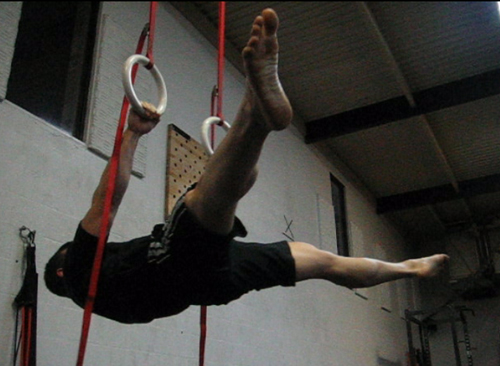
Straddle the legs, making sure to extend the hips. This will be easier or harder than the single leg front lever, depending on your flexibility. The more flexible, the wider your legs should go, and the easier it will be. I personally feel this progressive hold to feel the most awkward.
Pullups are possible in this position. Get your hips as close to your hands as you can. I try to keep my shoulders and hips in the same horizontal line, although my legs may move upwards slightly.
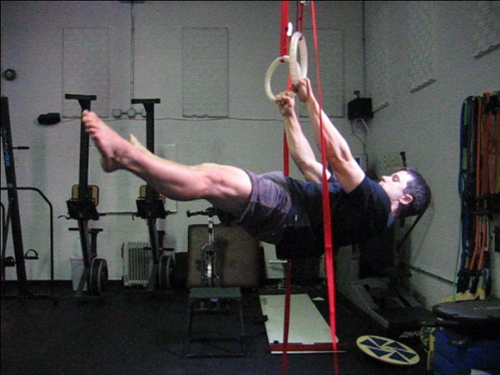
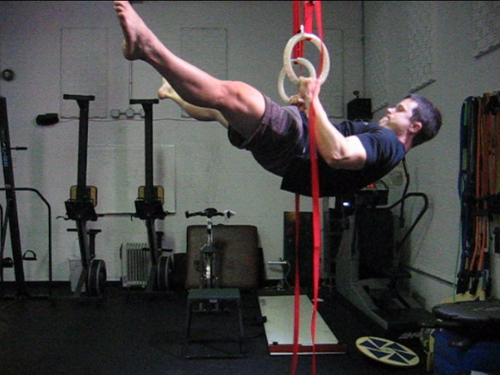
straddle lever pullups
Front Lever
.jpg)
You’ve made it. If you can lower down and hold the position, consider the skill hard fought and won.
“Ice Cream Makers”
It’s got a funny name, but the following exercise is great to strengthen things up once you’ve gotten a rudimentary front lever. It keeps tension on the back muscles, while giving the elbows a bit of a break.
Simply start on the rings with your palms facing you (my feet are off the ground).
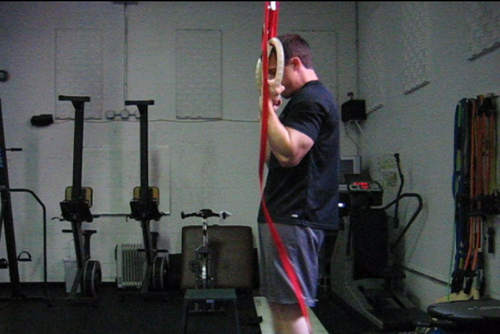
Next, lean back while keeping everything from feet to shoulders in a straight line
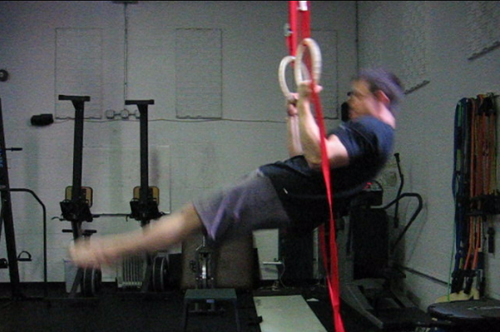
Spin your hands so that your palms face down towards your feet and extend your arms to end up in a front lever.
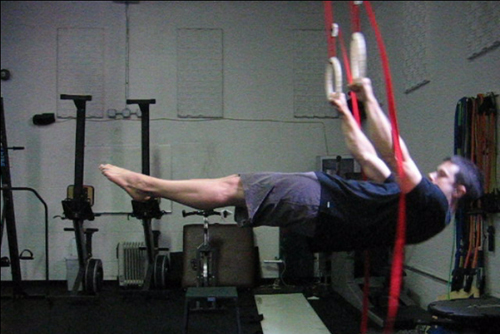
Immediately bend your arms, turn your palms back toward your body and bring yourself back to the beginning position. Repeating this several times in rapid succession is quite tiring.

Above and beyond
The one arm front lever
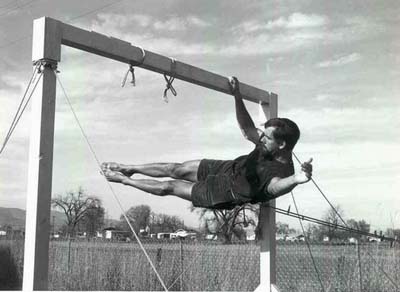
John Gill – One arm front lever
To increase the difficulty of this skill ten-fold, you can work on holding this skill with one arm. Both John Gill and Jasper Benincasa could hold this position with one finger!! As well as do a one arm chin-up in the front lever position!
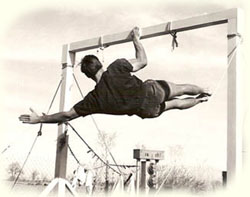
John Gill – One arm front lever pull-up
Jasper Benincasa, a chinning legend and teacher of Jack Arnow, gave the following advice:
“Slowly let yourself down. Turn your body a little to the side and straddle your legs.”
This was given in an interview between Brad Johnson and Jasper Benincasa, which can be found here. Brad Johnson, besides incredible accomplishments with one arm chin-ups and rafter chin-ups, has worked toward this skill by holding a kettlebell in the free hand to balance, as seen below:
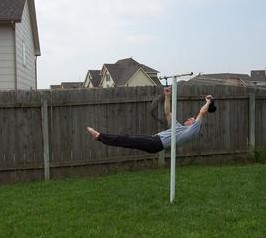
Brad Johnson and the assisted one arm front lever
I’ve tried the progressive exercise that Jasper suggests myself and it is quite difficult. Below I’m leaning off to one side in the straddle lever while attempting to provide a slight assistance with my right hand.
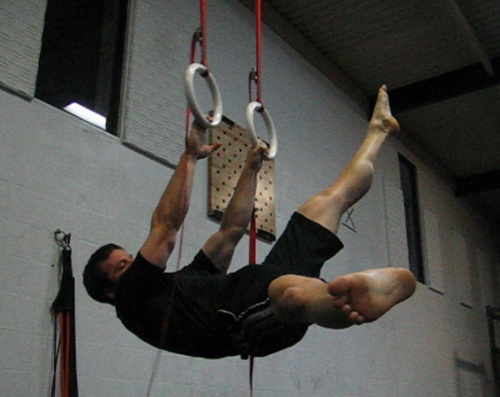
And here I’m working on a one arm tuck lever. I held this position for a fraction of a second, but could understand how it might be helpful to practice for the one arm front lever.
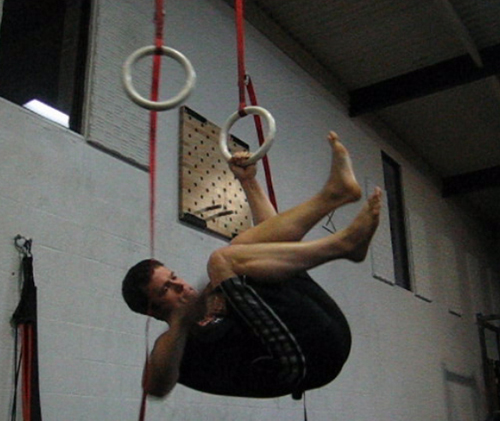
Whichever part of the tutorial you begin with – from pullover to one arm front lever, I hope this has helped. Best of luck and train hard!


Hi Jim,
I am to the point where I can do a front lever with my body looking like a slight “v”. Can’t quite get it straight yet. Seems like my abs are the part that is giving in first.
Do you suggest just to keep doing half levers until my abs are strong enough to do the full lever or some type of ab exercise?
Thanks!
Todd
It’s the shoulders, not the abs. Trust me.
Work on tucked lever positions that you can move through before you start extending your body into the more challenging lever positions. Good luck!
Abs Not shoulders. His abs give out before his shoulders do. Learn how to read and intreperate things. Get off the website beofre I ban you.
Just a heads up – the hyperlink to the muscle up page is broken. It goes to http://www.beastskills.com/MuscleUp.htm
When it should go to http://www.beastskills.com/the-muscle-up/
Thanks a lot. There were several broken links when the new site switched over. Again, thanks for the heads-up!
These are fantastic!
Exactly the kind of stuff we do in circus school for functional and practical strength conditioning!
Thanks so much!
Where do you go to circus school?
I go to Atlantic Cirque school of performing arts in Nova Scotia, Canada.
I’m taking the professional program there
Its a great facility and tons of fun!
hi jim! i can hold a single leg front lever for about 15 seconds and i train intensivly almost everyday. How long do you think it will take for me to get the full front lever? cheers!
Hi Jim
Several years ago you gave me some good advice on using weighted pullups.
I finally put it to good use and can finally do a front lever….holding at 5 seconds now and working on improving it.
I’m 62 and until finding your site for the first time, never even heard of a front lever.
Thanks Jim
John
Hey Jim,
I have been following your website since it’s inception or close to it. Anyway, I just recently started working on the front lever (3 months ago). I can do a full hanging leg raise and hold the L-sit for maybe 15 seconds.
However, I can’t even begin to do anything close to a back lever(never trained it).
Will this hurt my front lever progress? Is it easier to get the back lever first? As far as I can tell, it shouldn’t matter, but that’s just a guess.
Work on something you can successful do – like skin the cats – and move up from there. Good luck!
Jim,
Sorry, I phrased my question poorly, what I am really asking is:
Do you believe that the back lever is a pre-requisite to the front lever? Or is it ok to train the front lever without having mastered the back lever?
Also, what’s your best guess on how long it should take to learn the front lever?
Hey man, ive been practicing the front lever progression exercises, and up to now i managed 60seconds for the tucked lever, 30 seocnds on advanced tuck, and i can do 20 seconds with one leg front lever both legs at the same go. But im not able to even hold the straddle lever. Can u tell me how to learn the straddle? Or if there are any other progressions towards the straddle fl?
Keep working the holds, adding more and more sets. Also work on pulling up into the positions, if you haven’t do so before.
lol i have trouble just preogressing to the advanced tucked lever hold. i can do a tightly tucked lever EASILY now and can pull myself up to the position. do i gradually strech out in the advanced tucked lever so eventually it can look like the one you have in the pictures? thanks in advance
Yes, that’s the idea.
Hey mate, great site, excellent tips. Seriously, watching guys like you go at this makes me so friggin depressed with my own abilities.
The thing that I wonder about the the most is, I’ve done a fairly regular weights routine for quite a while, but I’m not very tall or heavy, 5’7″ and 74kg (163 lb). My upper body is reasonably developed (though not phenomenal) but for my size, I have big legs, especially quadriceps, thanks to years of squatting, leg pressing and sprint interval training.
I’ve decided I want a change and want to move into a much more calisthenics-y regime. I know that my hefty legs must work against me to some degree in calisthenics, because legs are just dead weight in gymnastics, right? How much of a problem would this pose for doing levers, human flags and that sort of thing? I would feel highly accomplished if I could perform these. But should I even bother trying? Is possible to strengthen the upper body enough to compensate for what is probably in my case a fairly over-developed lower body?
Thanks dude, sorry bout the long-winded question.
JJ
hey jim
i can do the whole front lever but i can stay more than 2 seconds , what should i do to improve it ?
cant
Hi, I am working on the front level too. For the time being I am doing to tuck level pull up, but my hips are not in a straight line from my shoulders, I guess this might be due to me not being strong enough. So maybe I should work on the skin the cat first ? Is it a big problem you think to just do tuck level pulls ups without having a horizontal body (will it be like doing planche training with bent arms ?
I also seem to get some injury in my forearm due to this exercise. Any suggestion about how to avoid it?
Hi, these lectures are great.
Do you have any tips on how to avoid injury in the forearms when training for a front level ?
I have trouble coming from the bottom position and actually holdingbit. I can do raises tucked, advanced tuck but havent tried straddle or one leg in and out. Any suggestions?
Keep working! Get stronger!
Hello Jim,
I’m 14 years old and i’ve been training the front lever for about 8 months now. However, I’m having trouble. I’m stuck with the one-foot progression for months, able to hold it for about 3 seconds. I can do tucked and advanced tucked FL pull-ups and can do a full ice-cream maker but can’t even get a BENT arm FL. Is it because of my age or overtraining? Any advice would be grately appreciated.